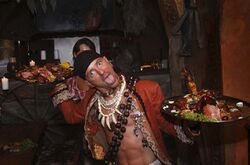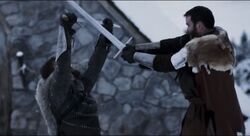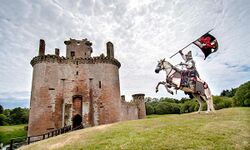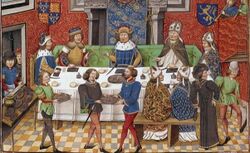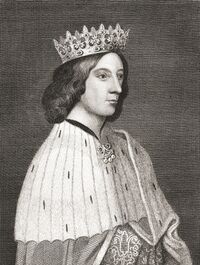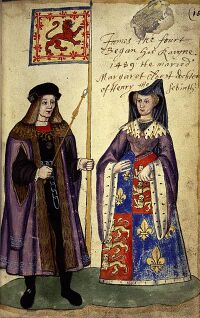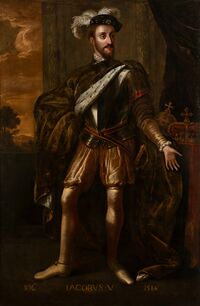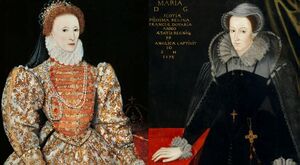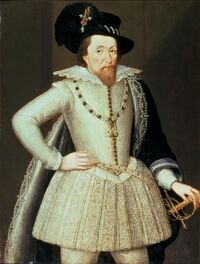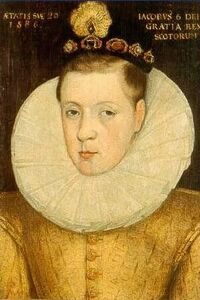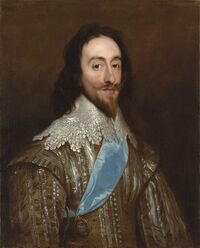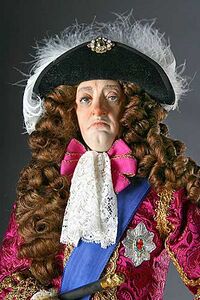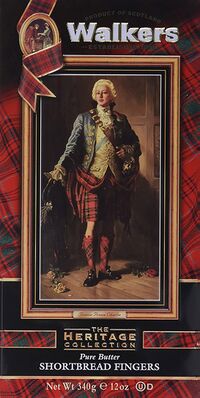House of Stuart
“Tartan skirts for everyone — no, everyone!!”
The House of Stuart was a British family who were kings for 500 years. They were originally a family of Parisian barmen who absconded with a pub's takings and fled to Scotland to avoid execution for stealing. In the 14th century, they became Kings of Scotland, and in 1603, they added England, Wales and Ireland to their collection. At about the same time, they changed their surname from Stewart to Stuart to sound a bit posher and put more distance between them and their heritage as manservants.
The former royal dynasty died out in 1807 when their last representative, Cardinal Henry Benedict Stuart, died in Rome in the bare arms of Pope Oh-So-Bloody-Pius VII. However, other Stuarts still survive today, some still styling themselves Stewarts. Head of this family is Sir Roderick 'Rod' Stewart, broken-glass-voiced singer with blond highlights. He lives in Essexy and has a golden throne with a large golden chain, as well as a stomach full of splooge.
Origins[edit]
History first brushed quills with the Stewarts in the 13th century, when a French stable-cleaner named Walter the Shit-Shoveller was promoted to steward. In those days, if you changed your occupation, you could change your surname, and he availed himself of the rule, becoming Walter the Steward and eventually Walter Stewart, spelling not being his personal forte.
Walter worked in London behind the bar at Westminster Hall. Abbey (the waitress) would write that he sampled too much of the merchandise as well, and when that night's bar takings showed a substantial loss, Walter — in the language of the day — legged it. To stay one step beyond the English justice system, Walter moved to Scotland. His superficial appearance of being 'civilised' impressed the Scots, and he soon found regular employment. One of his first patrons was another family of French origin: the Bruces. Originally known as the DeBruisers for their readiness to resort to fists when settling an argument, the DeBruisers/Bruces became regular bar patrons at Walter's pub.
Alliance with the Bruces[edit]
The Scottish monarchy had just pegged out in 1286, after the last king, Alexander III, fell off a cliff whilst riding his horse hard for some fun with local nuns. His only heir was a granddaughter, Margaret, who was living in Norway. A band of Scottish nobles concluded that this three-year-old ought not travel to Scotland to claim her throne; therefore, they would form a committee to look after the kingdom until she arrived. James 'Jimmy' Stewart was on this committee; he had been one of Alexander's creditors, by virtue of a considerable bar bill. Robert Not That Bruce (grandfather of that Robert the Bruce) was a major claimant to the Scottish throne, as a distant cousin of the late King Alexander. Jimmy consequently fed Robert all the inside gossip and told him that Margaret would travel to Scotland when she was a bit older. That was true, if off by three more years. Margaret set sail but succumbed to cultural introduction to her new realm; the Certificate of Death stated that she 'sickened and died from a surfeit of 'porridge' as so many of us do.
This would have made Robert Not That Bruce the next king, except for Scottish politics. There was a rival dynasty to the Bruces: another family of French origin known as the De Balliols, cousins of both the Bruces and the previous ruling house. The proper British way to settle this would have been civil war. However, this time the Scots gave the choice to Edward I of England. Edward was a notorious Crusader, anti-Semite and harsh obliterator of the cause of Welsh independence, so the Scots concluded the odds were remote that he would screw up this task as well.
Edward decided that John De Balliol would be King. However, hidden in the small handwriting was a provision that John would rule as a mere servant of Edward. When John tried to renege on his own agreement to be his own man, Edward invaded Scotland with his own army. John abdicated but was still dragged off to London and imprisoned. With the matter solved, Edward assumed the title of King of Scotland.
The Scots rallied around William Wallace and his rebellion on behalf of King John. The Scottish nobles, for their part, thought Wallace a peasant and declined to support him. This included both the Bruce and Stewart families. They cut deals with Edward to protect their own position against other Scottish lords in case English rule over Scotland caught on. This would become a common theme in Anglo-Scottish relations from then on.
Rebellion and independence[edit]
By the time Robert the Bruce (yes, that one) was proclaimed the Scottish king in 1305, William Wallace had been captured, tried, and chopped up into bits. This left no effective rival to Robert. The long Scottish war for independence would lead to the Battle of Bannockburn in 1314, when they smashed an English army.
Robert's best bud, Walter Stewart, was the Bruce's main supporter. For that, he was given permission to marry Bruce's daughter Margery. The couple had one surviving son, Robert Stewart, who would go on to become king, but not before Bruce's own son David got in first. David the Bruce became King of Scotland in 1329. He was only five. And married. His wife was King Edward III of England's sister Joan. She was a more mature eight.
David the Bruce can be classified as one of the 'unlucky' kings. The rival De Balliol family (under John Balliol's son Edward) invaded the country in 1332 and for a while controlled large areas of it, thanks to English backing. David was forced into exile until a return was engineered by French king Philip VI at start of the Hundred Years War. In return, David was to invade England. After some delay, David got news that King Edward III was in France with most of his army and so launched an attack. The Scots were defeated by a second-division English team and David was captured and taken to London for ransom. Robert Stewart (now a member of a regency council) balked at the hefty sum and opted to let David languish in prison. This allowed Robert Stewart to effectively rule Scotland for the next 11 years until David was finally released from the Tower of London and had to hitchhike his way back home.
King David still had no heirs. Not even a few bastards to boast any bedroom success. Queen Joan died in 1362. A second marriage was equally childless and David divorced her. He was still relatively young in those plague-infested years but in 1371 David died. Robert Stewart succeeded him, but was opposed by a faction led by the House of Douglas. They had supported Robert the Bruce earlier and had acquired a heroic reputation for beating the English. The Douglases thought the throne should at least be up for a competitive counter bid but found few willing to start a civil war. At least not yet.
Imprisonment, Piracy, Assassination, and Being Blown to Kingdom Come[edit]
Having waited so long for the crown, the Stewart family would find it hard to keep hold of it. Consider this. Robert II would end up deposed by his own son Robert III and left to freeze to death in a draughty castle. Robert III was kicked by a horse (not known exactly where) which left him a cripple. Fearing that his siblings would murder his only surviving son James, Robert had the young prince sent to France to escape from a knife in the back, only for James to be captured by English pirates and sold to King Henry IV of England. James sent to the Tower of London as a hostage. When Robert III died, James I was proclaimed king but actually only ruled one large room and a privy. Real power in Scotland was reserved for James's uncle Robert (a different one) who acted as regent for James but showed no interest in paying for his release from prison. James stayed there for the next 18 years.
James was let out after he agreed to marry Joan Beaufort. By now, his uncle Robert was dead, the regency carried on by his son Foxy Murdoch. He submitted to James, blaming 'paperwork' for the delay in freeing his monarch.
James had Murdoch and his two sons executed. This act trimmed down the Stewart royal family. It would go further. Another uncle called Walter who had helped in James's restoration turned against him. This may have been to do with his own sons dying mysteriously earlier (poisoned porridge?). Walter had James assassinated. This was organised in 1437, when the King was surprised at one of his homes by a band of killers who overwhelmed what security the king had and cut him brutally down.
The King's English-born widow Joan Beaufort took a bloody revenge on her husband's killers. Walter was sentenced to death, suffering the full grisly butchery usually reserved for rebellious peasants. He was tortured, hung (not enough to kill him), disemboweled, castrated and then chopped into bits. What was left ended up in a doggy bowl. Joan's son King James II was still a young boy, though his looks made him look permanently angry. He had a large red birthmark covering most of his face.
If murdering your own kinsmen was becoming something of a Stewart trait, they had no issue doing the same to the Douglas family. The family thought highly of itself because of their part in the war for Scottish independence. By the 1440s, the family had split into two mutually hostile branches: The Black Douglases and the Red Douglases. Moreover, the Black Douglases also hated each other. In 1440 at a dinner party, the young King James (aged 10) witnessed the execution of the then-Earl of Douglas and his younger brother by their great uncle — another Black Douglas, who therefore inherited his dead relatives' lands. The Black Douglas clan was in turn killed or driven into exile by King James a few years later, their lands in part going to the Red Douglas family.
Amongst these murderous feuds, King James was lucky in part that England was going through its own localised bloodbath with the War of the Roses. King James opted to support the Lancastrians, who repaid him by letting him reclaim some autonomous border towns that were technically part of Scotland. One of these towns was Roxburgh. In 1460, James took an army to besiege the town. He also brought a huge cannon which, he was assured, would blow the rebel town's walls down. James took a vantage point close to the cannon when it backfired and killed everyone within 15 yards, including King James. A violent end to a violent reign.
Murder and death[edit]
Another new king, another child ruler. James III was only nine when his father was killed. His mother Mary of Guelders became regent of Scotland but she died two years later, though not before gaining Berwick for Scotland. James had an ambitious younger brother Alexander who hoped to supplant him with either Scottish or English assistance. James III was a dullard, but he did acquire some new territory for Scotland, the Orkney and Shetland islands that had been part of the sprawling Danish-Norwegian-Swedish (sometimes) empire known as the Union of Kalmar. When their permanently broke king Christian I wanted to marry his daughter Margaret to James, the latter agreed not to take a dowry but suggested the Orkney and Shetland as surety for the debt. Christian failed to come up with the money to pay off this mortgage, so the islands became part of Scotland.
This was about the only success for James. His brother Alexander successfully invaded Scotland in the early 1480s with an English army. This saw Berwick returned to England, Alexander installed as Alexander IV, and James consigned to a prison cell in Edinburgh. However, once again in Scottish politics, many nobles now switched sides and James was released. Alexander fled into exile and then returned, only to end up in the same prison cell occupied by his brother earlier. Alexander got away again, went to France and died in a supposedly friendly tournament joust.
With no other brothers now surving (another potential rebel called John had been poisoned earlier), King James should have had time for a breather. Instead he fell out with his eldest son James and indicated that he favoured a second son — also called James — to become king after him. This led to yet another Stewart family feud and the death of King James when his army was defeated in 1488. His successor was the elder James who had fought against his own father. This one became King James IV.
Unlike his father and grandfather, King James IV was judged old enough to rule without regents. He was aged 15 which was considered to be mature enough in those days. Of immediate concern was the position of England. The latter had a new dynasty — the Tudors — in control. The Plantagenets had managed to wipe each other out and allowed an extremely obscure — and Welsh — family to replace them. The Tudor King Henry VII was eager to form marriage alliances. James IV for his part supported rivals to Henry to unsettle the English until he thought he could get a good deal from his powerful neighbour. Henry's daughter Margaret was made available and so she and James married in 1503. Despite the marriage, James kept his foreign policy options open. In 1513 he allied with France against Henry VIII of England and invaded the Northumberland. King Henry was in France when this happened but his wife Queen Catherine (acting as regent in his absence) sent an army to fight the Scots. James was killed in battle, alongside most of his nobility. The English took the body of the Scottish king from the battlefield, pickled it in brandy and sent it to London for inspection. It was never returned to Scotland and disappeared shortly after. This lead to rumours that James IV had not died but had instead escaped into exile or disappeared into a mountain waiting for better days.
Broken heart; also, execution[edit]
The Stewart family's extraordinary bad luck continued, as three more toddlers ascended (or perhaps 'crawled up to') the Scottish throne:
| Year | Toddler | Age at inauguration |
|---|---|---|
| 1513 | James V | 16 months |
| 1542 | Mary Queen of Scots | Six days |
| 1567 | James VI | 13 months |
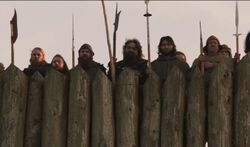
James V's early years saw his mother Margaret abandon him for a new lover Archibald Douglas, 6th Earl of Angus. He was one of the few Scottish nobles who avoided getting spiked on English spears at the Battle of Flodden. James grew up to be a weedy, unimpressive king. His country bounced between being allies and then enemies of the English king Henry VIII. James relied on the alliance with France to protect him and travelled there (without getting captured by the English) in 1537 to contract a marriage with a suitable bride. The one chosen for him wasn't to his taste, he instead took a fancy to King Francis I of France's daughter Madeleine of Valois. Francis was very reluctant, the Scottish climate and cuisine had killed many before. James insisted, perhaps suggesting he would drop by to London to see if he could find anyone there to marry instead. Francis relented. James returned to Scotland with Madeleine. She was dead in six months.
James's choice for another wife from France was Mary of Guise, a tall strongly built woman from the powerful Guise family. Mary was a widow and had a son by her first marriage. She was sent to Scotland by the King of France. James was happy. The couple had two sons but they both died very young. A third child was born called Mary, born in 1542. James wasn't there for the birth as he just got Scotland involved in another war with England in an alliance with France. The Scots dismal run of battlefield disasters continued. They were defeated yet again. James escaped but then took to his bed and refused to eat. When he received news that he was a father of a baby girl James said 'Sod it' and died.
Mary of Guise who handily had some French troops with her in Scotland as part of the alliance with France managed to take control of the country. Mary Queen of Scots became the first woman in the British isles to rule by her own right of succession. She was an heiress and though Scotland wasn't considered to be wealthy country unless you liked shortbread and whisky, it offered a way to counter any expansionist aims of England (including Wales and Ireland). Henry VIII wanted Mary to marry his son and heir Edward (later Edward VI). The Scots once again tried to defend themselves against England and went down to another defeat! However Mary's mother got her out of Scotland and with the promise the baby queen would marry a French prince.
For the next 13 years Mary lived in France. She was married to the French dauphin Francis (later King Francis II). Besides Scotland, she also now had a claim on the English throne if Queen Mary Tudor died without issue. Since Mary Tudor was married to the King of Spain, she was no friend of of Mary Queen of Scots even if both women were Catholics. Mary Tudor's sister Elizabeth succeeded but as she was a protestant, Mary Q of S said heretics couldn't rule and claimed England as well. Not long after her French father in law died and Mary was proclaimed Queen of France, England, Scotland and Ireland. That would be the high point of her life.
In 1560 Mary's husband died. She was a widow and had no child by Francis so France reverted to his younger brother. Mary now had no role there so took ship back to Scotland. Her mother had ruled in her name for the last 18 years but died before her daughter returned, a somewhat convenient outcome to suggest this was no accident. Scotland had by now also got into the swing of the protestant reformation, except their version was a Calvinist one under the authority of the old bigot, misogynist and unfunny preacher John Knox.
Mary's personal rule of Scotland lasted only from 1560 to 1567. She was in a weak position. The French who had helped keep Scotland away from England were now enaged in their own civil conflict between rival catholic and protestant factions. The English supported the protestants in Scotland (though less keen on them being mainly Calvinists) who now gained the upper hand. The other issue was who should Mary now marry? One has to remember that single women ruling a country — as was now the situation in England too — was always something that bothered in an aggressive masculine nobility. Scotland was no different. Mary eventually agreed to marry one her Stewart cousins, a foppish if cruel Henry Lord Darnley. He got to marry her but she refused him to become king in case he sidelined her. The marriage produced one son — the future James VI — but was a grisly affair. A plot to blow up Darnley in one of his homes failed when the prince slipped out the back door before the explosives could be lit. However a Plan B then kicked in and Mary's husband was suffocated by as assassin with a duvet.
Widowed again and this time determined to marry for love instead of duty, Mary married James, Earl of Bothwell. He was even by the standards of aristocratic behaviour in the 16th century a disreputable character and thought of someone who had arranged the murder of Darnley. Other Scottish nobles rebelled and Mary was imprisoned. Bothwell managed to escape. A few weeks later Mary was forced to abdicate in favour of her son. She managed to escape with help but her attempt to reverse her abdication failed. Unwilling to be captured again and imprisoned (or worse), Mary fled to England. There she would stay for the next 20 years; it was a baleful experience. Mary's past claims to the English throne were not forgotten. She was also still a staunch catholic and so someone English catholics could consider their rightful queen rather than Queen Elizabeth. They involved Mary in their plots to kill Elizabeth. Mary was accused of treason against Elizabeth. It got Mary executed in the end. She never met Elizabeth.
Stewart to Stuart[edit]
James VI was an extremely ugly man. He was of middle height, wore a large hat to make himself look taller and stuffed his stockings with padding to give his legs a 'more muscular look'. He never knew his father (if Lord Darnley was the father) and his mother Mary was in an English prison. She wrote to him repeating her claim that she was still monarch and James was a naughty boy for getting her out of an English clink. James rarely rarely returned the favour, sending Mary empty bottles of whisky.
The Scottish king's childhood was no less bloody. The country was controlled by regents who had a tendency of being shot dead or dying in mysterious circumstances. He killed his last regent on the instigation of a Scottish cousin with the name of Esme Stuart who was living in France. So enamoured was young James of Esme that there were strong rumours that the two men were lovers as well. When James's regent Lord Morton tried to get Esme thrown out of Scotland for 'French effeminacy', the king instead chose to have his official guardian executed instead. Esme disappeared back to France but James was so taken with the alernative spelling of Stewart as Stuart, he chose to adopt that as the family's new name.
It became increasingly obvious that Queen Elizabeth of England wasn't going to marry. James's mother had a prior claim if anything happened to Lizzie but as a Catholic she was judged to have debarred herself. Elizabeth made sure Mary wouldn't succeed her by simply having her executed for treason. This did cause a bit of stink in Europe. King James on his part made no special plea for Mary and sent a secret note to Elizabeth saying 'get on with it and name me your official heir'.
Still waiting for an answer from England, James moved on to selecting himself a bride. It was a somewhat limited field. He could of course married Elizabeth himself but that would have meant no children so instead he went on a cruise to Denmark where he met his bride-to-be, a rather dull Danish princess called Anne. Her father King Frederick II of Denmark convinced James to marry his daughter and threw in a new Scandinavian-style kitchen to seal this particular deal. Remember this was a time when women's role in society at even the hightest level was essentially being a good breeder. So a kitchen offer+bride was about the going rate then.
For the next few years James waited patiently for 'the old bird' to die as he called Elizabeth. His marriage to Anne was successful as they had two sons and one daughter who managed to dodge an early death and grow into adults. Elizabeth kept him waiting until 1603, refusing to the last to confirm James as her heir. When she died, James and his family were in London in a week. For James who had grown up as a relative dirt poor king in a cheapjack realm known as Scotland, his new throne of England was like winning the top prize. So happy was James by this he only went back home once, to check if people who owed him money had paid up.
Gunpowder and a new Bible[edit]
The novelty of a man as king again — and speaking English, though with a hoary brogue peppered with obscure obscenties — wasn't universally popular. The extreme Protestants of England were encouraged that James came from a strongly Calvinistic state and hoped to see it replicated in their country. Meanwhile, the Catholics who remembered James's mother Mary hoped for better treatment. And then there were others who just wanted to blow up a king. Considering the Stewart/Stuart family luck, this could have easily occurred if the Gunpowder Plot hadn't been discovered just before Guy Fawkes was about to light the fuse. James survived. The plotters got thoroughly butchered for a public spectacle with paying customers.
For the first time, Britain, Ireland and associated islands were under the rule of one monarch. That meant a name change. The new state was called the 'Great Britain'. James was king of three states (England and Wales, Scotland and Ireland) and maintained the old claim to the throne of France as well. For a family of bar stewards, it had been a remarkable rise in power.
In 1611, James was approached to write the preface to a new translation of the Bible. As always, James demanded a payment and dedication for his support. So it became the King James Authorised Bible Gold Star Version and was to replace all existing translations and appear on the nightstands of a thousand motel rooms.
Family matters came next. Eldest son Henry died just after he learnt how to shave. This made his younger brother Charles next in line for the throne. James's daughter Elizabeth appeared to have made a good match in Germany and, for a while, was Queen of Bohemia on account of her louche lifestyle. However, that was soon lost, as were her German home and possessions. She was reduced to sending begging letters to her father. As with his mother before, James binned them.
Charlie gets the chop[edit]
King Charles I was very small. Very small. But he had big ideas. He thought he had a direct line to God. To English ears, he sounded more like them; no more King James and his weird mangling of the Mother Tongue. Becoming king in 1625 and still a virgin, he hurried off to Europe to go bride-hunting. This time, he waved away any ideas of marrying a Protestant and after Spain refused his wooing of one of their princesses, Charles took a fancy to Henrietta Maria, daughter of King Henry IV of France. The couple married, but as Henrietta refused to convert to Protestantism, she missed out on a coronation (robes and the chicken).
If Charles had been anything else but a king, he may have been one of those boring type of people you meet at parties. Happily married, no known hanky-panky outside the marital bed, Charles stuck to his decisions, even if they were a disaster. It was through this and his personal dislike of the English Parliament and its venal politicians that he tried to rule without them. This led to the English Civil War. In fact, this war raged throughout the United Kingdom. At any other time, this could have seen active foreign intervention, but the rest of Europe was still in deep with the Thirty Years' War.
Charles was eventually beaten. Surrended to a Scottish army in they hope they would treat him nice. Got 'kingnapped' by Oliver Cromwell who — equally believing he was on-line with the Almighty — had Charles put on trial, found guilty and head chopped in January 1649. That was the end of Charles and, it seemed, of the Stuarts. Ahhh...but there was more.
Exile, Restoration, Bastards and Exile Again[edit]
Charles I was dead but his eldest son Charles II was still very much alive. A bit taller than his father and considered better company, he was the total opposite of his father in most things. First thing, he loved the ladies. He tried to go up against Cromwell but was driven out. Forced to live in Holland on cheese and tulips, Charles was eventually restored when the English got fed up with living under a godly government of the Cromwell family. In 1660 Charles was back. He already proved he could have children by knocking off one of his female fans and siring a son called James, late known as the Duke of Monmouth. Charles did marry for real — this time a Portuguese princess. She came with a few colonies as part of her dowry, in particular Mumbai (Bombay then) and a bag full of peppers.
At first King Charles II stayed out of trouble. He was thoroughly unfaithful and fathered so many illegitmate sons that many ended up in the House of Lords where a few still linger today. Catherine gave him no heirs so his successor would be Charles's younger brother James. He was also a bed hopper, fathering a son called James (later Duke of Berwick) but — and it was important — a fierce and public Catholic. He did have two daughters Mary and Anne by his first wife who were baptised protestants and married off to the ruler of Holland, a fruity faced prince called William of Orange and the son of the King of Denmark (that connection again) called George.
It was during this time that the fear of a new Catholic plot to takeover England saw the rise of new political factions called the Tories and Whigs. Charles didn't want a re-run of the civil war so dodged around the problem of his succession. He tried to say that his brother had 'a dicky heart' and would die in accident if his centre of gravity located in his wig shifted. Moreover since James's heirs were protestants, there was no need to worry. When James's first wife died and he married a younger woman; again the message was 'It will all be alright.'
Charles II died in 1685, making a secret death bed conversion to Catholicism. James became king. He as still Catholic but tried to compromise by encouraging religious toleration for everyone. This was actually quite an advanced political position but he was distrusted. A rebellion by the Duke of Monmouth against him was defeated and James allowed his bastard nephew to die under the axe just like his grandfather.
In 1688 James became a father again, this time his wife Mary gave birth to a son who was called James after his father. The boy survived. By the laws or rules of the royal game, Little Jimmy Stuart trumped his big sisters in the succession. That was enough for the Catholicphobes. They rebelled and invited Mary and her husband William over to become next monarchs. James, his wife and son were forced into exile.
The Pretenders[edit]
James's exile meant the Stuart dynasty was now represented by Mary II and then her sister Anne. They were the last ones to rule from this most adaptable, if unlucky, family. James II died in exile, his son was proclaimed 'James III & VIII' in 1701. The Stuart ill fortune continued. Neither Mary or Anne had children that lived any length of time. So when Queen Anne died in 1714, it was the descendants of the Bohemian Queen Elizabeth who became the ruling dynasty. These were known as the Hanoverians. They were scarcely better than the Stuarts but had the right religious credentials.
James 'the Old Pretender' stuck with his Catholic religion as did his eldest son Bonnie Prince Charlie, 'the Young Pretender'. Their supporters became known as the Jacobites, the most lostest of all lost causes. They almost pulled off it off in 1745 when Bonnie Charlie reached Derby with an army to overthrow George II. The latter had packed his suitcases and was about to flee back to Germany when Charlie lost heart and retreated. A military defeat in 1746 sealed the fate of the Stuarts. There was going to be no Frank Sinatra comeback for them.
End of the line[edit]
'Charles III'[1] married but had no heirs. The Bonnie pseudo king did have a bastard daughter but she was excluded from the succession. Charles's younger brother Henry had joined the Catholic Church and had made Cardinal. When Charles died in 1788, Henry took over the empty claim as England, Scotland, Ireland (and France)'s missing monarch. Henry ended up as a refugee in exile during the time of Napoleon and died in 1807, apparently surviving thanks to discreet brown envelopes of money sent weekly by King George III. Why George was doing this isn't clear but he was declared loco a few years after Henry died.
A few Stuarts (or Stewarts) have lingered on. The heirs of King Charles II's original bastard sons still survive. Descendants of James II's son the Duke of Berwick are now part of the Spanish aristocracy. There are a few Stewarts still in Scotland. There is ot course Rod Stewart but otherwise, that's it.
Now I need a drink. Steward! I am sailing!!
References[edit]
- ↑ Surrounding this Jacobite claimant with quotation marks became obligatory in 2023, when a Windsor took the British throne as Charles III.
| ||||||||||||||||
